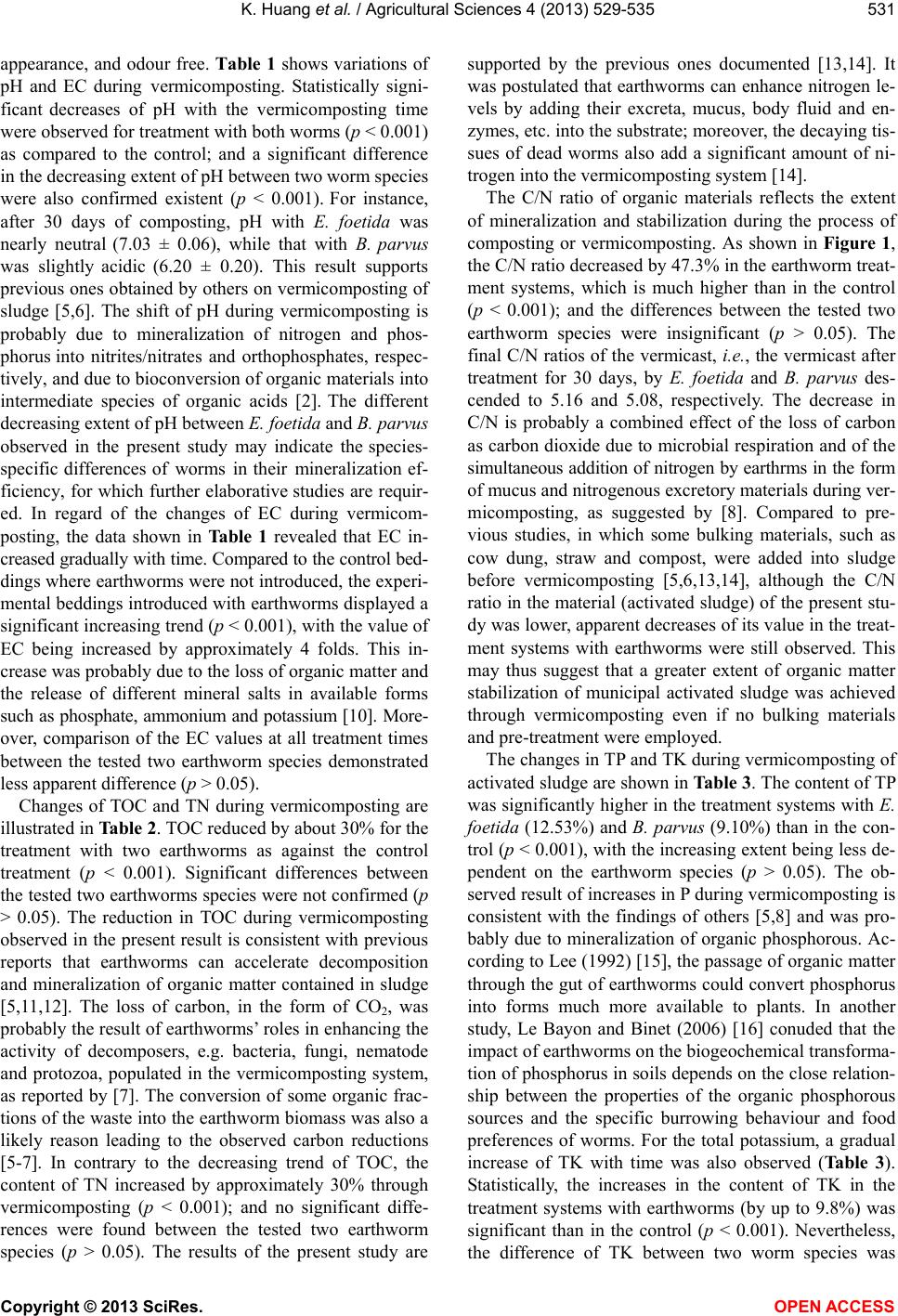
K. Huang et al. / Agricultural Sciences 4 (2013) 529-535 531
appearance, and odour free. Table 1 shows variations of
pH and EC during vermicomposting. Statistically signi-
ficant decreases of pH with the vermicomposting time
were observed for treatment with both worms (p < 0.001)
as compared to the control; and a significant difference
in the decreasing extent of pH between two worm species
were also confirmed existent (p < 0.001). For instance,
after 30 days of composting, pH with E. foetida was
nearly neutral (7.03 ± 0.06), while that with B. parvus
was slightly acidic (6.20 ± 0.20). This result supports
previous ones obtained by others on vermicomposting of
sludge [5,6]. The shift of pH during vermicomposting is
probably due to mineralization of nitrogen and phos-
phorus into nitrites/nitrates and orthophosphates, respec-
tively, and due to bioconversion of organic materials into
intermediate species of organic acids [2]. The different
decreasing extent of pH between E. foetida and B. parvus
observed in the present study may indicate the species-
specific differences of worms in their mineralization ef-
ficiency, for which further elaborative studies are requir-
ed. In regard of the changes of EC during vermicom-
posting, the data shown in Ta b l e 1 revealed that EC in-
creased gradually with time. Compared to the control bed -
dings where earthw orms were not introd uced, the experi-
mental beddings introduced with earthworms displayed a
significant increasing trend (p < 0.001), with the value of
EC being increased by approximately 4 folds. This in-
crease was probably due to the loss of organic matter and
the release of different mineral salts in available forms
such as phosphate, ammonium and potassium [10]. More-
over, comparison of the EC values at all treatment times
between the tested two earthworm species demonstrated
less apparent difference (p > 0.05).
Changes of TOC and TN during vermicomposting are
illustrated in Table 2. TOC reduced by about 30% for the
treatment with two earthworms as against the control
treatment (p < 0.001). Significant differences between
the tested two earthworms species were not confirmed (p
> 0.05). The reduction in TOC during vermicomposting
observed in the present result is consistent with previous
reports that earthworms can accelerate decomposition
and mineralization of organic matter contained in sludge
[5,11,12]. The loss of carbon, in the form of CO2, was
probably the result of earthworms’ roles in enhancing the
activity of decomposers, e.g. bacteria, fungi, nematode
and protozoa, populated in the vermicomposting system,
as reported by [7]. The conversion of so me organic frac-
tions of the waste into the earthworm biomass was also a
likely reason leading to the observed carbon reductions
[5-7]. In contrary to the decreasing trend of TOC, the
content of TN increased by approximately 30% through
vermicomposting (p < 0.001); and no significant diffe-
rences were found between the tested two earthworm
species (p > 0.05). The results of the present study are
supported by the previous ones documented [13,14]. It
was postulated that earthworms can enhance nitrogen le-
vels by adding their excreta, mucus, body fluid and en-
zymes, etc. into the substrate; moreover, the decaying tis-
sues of dead worms also add a significant amount of ni-
trogen into the vermicomposting system [14].
The C/N ratio of organic materials reflects the extent
of mineralization and stabilization during the process of
composting or vermicomposting. As shown in Figure 1,
the C/N ratio decreased by 47.3% in the earthworm treat-
ment systems, which is much higher than in the control
(p < 0.001); and the differences between the tested two
earthworm species were insignificant (p > 0.05). The
final C/N ratios of the vermicast, i.e., the vermicast after
treatment for 30 days, by E. foetida and B. parvus des-
cended to 5.16 and 5.08, respectively. The decrease in
C/N is probably a combined effect of the loss of carbon
as carbon dioxide due to microb ial respiration and of the
simultaneous addition of nitrogen by earthrms in the form
of mucus and nitrogenous excretory materials during ver-
micomposting, as suggested by [8]. Compared to pre-
vious studies, in which some bulking materials, such as
cow dung, straw and compost, were added into sludge
before vermicomposting [5,6,13,14], although the C/N
ratio in the material (activated sludge) of the present stu-
dy was lower, apparent decreases of its value in the treat-
ment systems with earthworms were still observed. This
may thus suggest that a greater extent of organic matter
stabilization of municipal activated sludge was achieved
through vermicomposting even if no bulking materials
and pre-treatment were employed.
The changes in TP and TK during vermicomposting of
activated sludge are shown in Table 3. The content of TP
was significantly higher in the treatment systems with E.
foetida (12.53%) and B. parvus (9.10%) than in the con-
trol (p < 0.001), with the increasing extent being less de-
pendent on the earthworm species (p > 0.05). The ob-
served result of increases in P during vermicomposting is
consistent with the findings of others [5,8] and was pro-
bably due to mineralization of organic phosphorous. Ac-
cording to Lee (1992) [15], the passage of organic matter
through the gut of earthworms could convert phosphorus
into forms much more available to plants. In another
study, Le Bayon and Binet (2006) [16] conuded that the
impact of earthworms on the biogeochemical transforma-
tion of phosphorus in soils depends on the close relation-
ship between the properties of the organic phosphorous
sources and the specific burrowing behaviour and food
preferences of worms. For the total potassium, a gradual
increase of TK with time was also observed (Table 3).
Statistically, the increases in the content of TK in the
treatment systems with earthworms (by up to 9.8%) was
significant than in the control (p < 0.001). Nevertheless,
the difference of TK between two worm species was
Copyright © 2013 SciRes. OPEN A CCESS